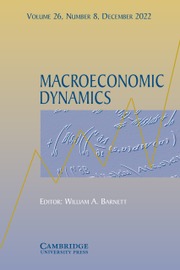No CrossRef data available.
Article contents
Financial frictions, monetary policy, and the term premium
Published online by Cambridge University Press: 14 March 2025
Abstract
This study investigates the contribution of financial frictions in term premiums on long-term bonds within a production economy. We consider a New Keynesian model, featuring an agency problem between financial intermediaries and their private creditors and generalized recursive preferences. The model predicts that financial frictions that amplify the impact of structural shocks on key macroeconomic variables increase term premiums under our baseline calibration. Furthermore, financial frictions produce a larger term premium when monetary policy is geared toward output over inflation stability. The novel mechanism that financial frictions increase term premiums are associated with the bank balance sheet channel of monetary policy.
Information
- Type
- Articles
- Information
- Copyright
- © The Author(s), 2025. Published by Cambridge University Press

